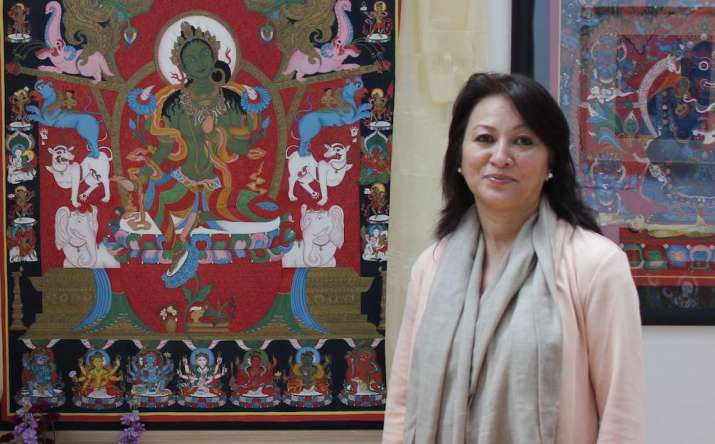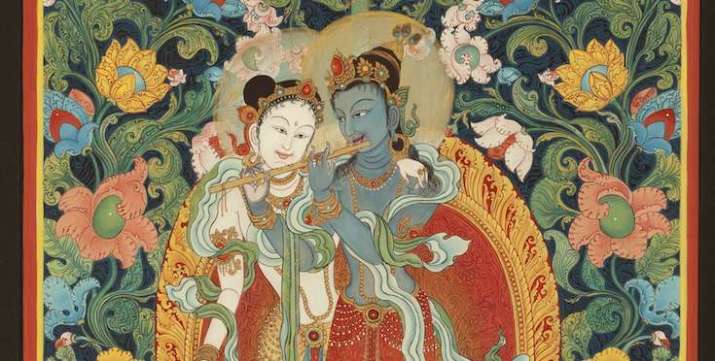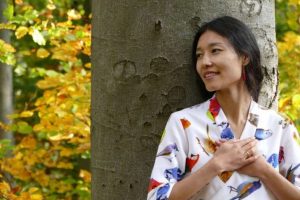Welcome to part two of our interview with Renuka Gurung, a leading master and scholar of the traditional paubhā paintings of Nepal. She studied the traditional method of early paubhā painting with the late Vajracharya priest Badri Ratna Guruju, spending 10 years learning the technical aspects of painting contemporary paubhā from Lok Chitrakar at his studio, Simrik Atelier, in Nepal. Four of her paintings were selected by Britain’s Prince Charles for an exhibition to mark his 70th birthday, along with his other favourite works by artists representing the prince’s charities, and displayed in the state gallery of Buckingham Palace. The exhibition, Prince and Patron, was open to the public from 21 July–30 September last year.

Buddhistdoor Global: What are the key differences between thangka and paubhā paintings?
Renuka Gurung: Paubhā is exclusively a traditional sacred painting that comes from the palettes of the Chitrakars of the past, Newar Buddhist painters. It enjoys a high status in bahas (monasteries) and bahis (nunneries) as well as within the Newar Buddhist community. Although paubhā has images, mandalas, symbols, yantras, and so on relating to Buddhist philosophy, it also portrays Brahmanical, Vaishnava, and Shakta iconographies. This magnificent Newar style of paintings paubhās or frescoes was very popular in the past, especially in places such as the Sakya monasteries of Nepal or Tibet’s Ngor Monastery, as well as in the Buddhist caves of Dunhuang.
Thangka mainly express religious themes, often painted by monks or religious masters, and are used as a medium for meditation and veneration by the Tibetan Buddhist community and other Buddhist communities around the world. Thangka paintings are visual representations of Tibetan Buddhist practice, lineages, masters, and their teachings. Paubhā are a reflection of the socio-religious practices and belief systems of the early Newar Buddhist community of the Kathmandu Valley. Summarized, the key difference between paubhā and thangka lies in the space that they occupy in the Newar and Tibetan Buddhist communities, respectively, as well as in the different styles and the way they are represented.
BDG: Is there any particular reason why Tibetan thangka are more popular than paubhā?
RG: I think the reason why thangka are better known and have gained popularity around the world is simply because of the way they have been shared and presented. Buddhist monks and the people rendered equal space and respect to thangka both inside sacred spaces (monasteries) and outside sacred spaces (the public sphere). In contrast, paubhā have sadly been less shared, even within the Newar community, much less to the Nepali public or the outside world. However, I feel that a big shift has occurred in the field of paubhā painting. By this I mean that there has recently been a focus on paubhā paintings as collectable works of art, so as an “art” rather than a “practice,” and this is clearly evident in the contemporary context.
BDG: You say that we need to truly understand what the word “revival” means in the contemporary context. How does this relate to other forms of sacred art, for example in the general context of art history?
RG: It is a joy to know that people have now begun to look at their tradition differently and are trying to revive it. To do so authentically, we have to look at what is missing or has been lost, something that is crucial to take into account. We often forget to nurture the very roots that hold the tradition together; the language of paubhā and all of the traditional practices associated with the painting of paubhā. I believe that in order to revive our tradition first we need to nurture these roots of the tradition.
Today, modern people are seeking meaning beyond daily work and life, to return to their roots by preserving their heritage and traditional practices. For me, having studied the traditional arts of other cultures as a part of my doctoral research, I can say that similar discussions are happening in other similar contexts. There is an aspect of traditional arts that is universal, transcending any particular time or geographical space, and that reveals the beauty of the different languages of each culture’s traditional arts. I feel that in these challenging times there is something to be learned from those interested in traditional arts in other contexts, those who face similar questions. In fact, it might be interesting to discuss these common issues and ideas in a symposium or forum one day.

BDG: Was paubhā only used for devotional purposes in the past?
RG: From the Chitrakars, paubhā painters, local people, Vajracharya priests, Shakyas, and historical publications, it is evident that the paubhās were painted to cater to the spiritual needs of the Newar Buddhist community. Based on this fact, we can say that paubhās in the past were used for devotional purposes. Their use seems to have changed greatly in more recent times; although the specific trajectory of these changes needs more study.
BDG: Do you think can we call them paubhā if they are not following traditional practices? I think a similar discussion needs to happen for thangka, where there is also a lot of work being done by contemporary artists that tap into traditional iconography.
RG: That is a very important question, but not one that should be answered by me or by any one person. At this time, what is most important is for discussions to begin, for questions to be posed, especially as there is lots of pressure on painters to alter their practices due to the tourist market or the international art market. These kinds of pressures mean that there is a lack of clarity.
The first thing that we need to do is to begin discussing terms to have a more profound discussion of just what we are dealing with. For such discussions we need to gather everyone engaged in this field of painting paubhā—not just the painters, dealers, curators, but also the lay community who partake in the festivals and rituals, monks, Vajracharya priests, and the respective authorities in the government who have these paintings for personal use and consider them national heritage.
To sum up, change in any sphere of life is inevitable as time progresses and a healthy tradition can adapt to change as it continually renews itself through the efforts of new generations. No one can stop pure change, but in the meantime I would like to say that it is worth pausing to look back to the past and to contemplate on what our ancestors handed down, to try to comprehend the meaning and impetus behind it. I am sure that the answer lies within the time and space of that deep contemplation.
BDG: What does the future hold for paubhā art?
RG: When I look back 20 years or so, the word paubhā was rarely mentioned or known, even among the Newar community in Nepal. However, now it is the other way round. This is a good sign.
I see the future of paubhā as being very bright. But again, the point here is that the future of paubhā depends on those who nurture it, how they choose to practice, and what they choose to emphasize as the tradition is handed on to future generations. It is an extremely important time as it is our generation who will make the choices about what to pass on in an era when traditional arts and practices are under threat around the world. Therefore, we need to be mindful of what type of future we wish to see for paubhā and for other traditional arts of Nepal, for our cultural heritage, as well as our role in relation to future generations.











